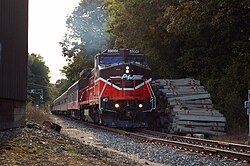 | |||
 Providence and Worcester GE B40-8W leads a passenger excursion for railfans at Plainfield, Connecticut in 2012 | |||
| Overview | |||
|---|---|---|---|
| Parent company | Genesee & Wyoming | ||
| Headquarters | 381 Southbridge Street, Worcester, Massachusetts | ||
| Reporting mark | PW, PWRZ | ||
| Locale | Connecticut, Massachusetts, and Rhode Island; New York City and Long Island via trackage rights | ||
| Dates of operation | 1847– | ||
| Technical | |||
| Track gauge | 4 ft 8+1⁄2 in (1,435 mm) standard gauge | ||
| Length | 612 miles (985 km) (including trackage rights) | ||
| Other | |||
| Website | Official website | ||
| |||
The Providence and Worcester Railroad (P&W; reporting mark PW) is a Class II railroad operating 612 miles (985 km) of tracks in Rhode Island, Massachusetts, and Connecticut, as well as New York via trackage rights. The company was founded in 1844 to build a railroad between Providence, Rhode Island, and Worcester, Massachusetts, and ran its first trains in 1847. A successful railroad, the P&W subsequently expanded with a branch to East Providence, Rhode Island, and for a time leased two small Massachusetts railroads. Originally a single track, its busy mainline was double-tracked after a fatal 1853 collision in Valley Falls, Rhode Island.
The P&W operated independently until 1888, when the New York, Providence and Boston Railroad (NYP&B) leased it; four years later, the New York, New Haven and Hartford Railroad obtained the lease when it purchased the NYP&B. The P&W continued to exist as a company, as special rules protecting minority shareholders made it prohibitively expensive for the New Haven to purchase the company outright. The New Haven continued to lease the Providence and Worcester for 76 years, until the former was merged into Penn Central (PC) at the end of 1968. Penn Central demanded the shareholder rules keeping P&W alive be rewritten, and also threatened to abandon the company's tracks. In response, a group of P&W shareholders launched a fight with PC, asking the Interstate Commerce Commission (ICC) to cancel the lease and let the P&W leave the New Haven's merger and go free. Against expectations, the ICC agreed, and after court battles, P&W prevailed and began operating independently again after 85 years. Upon regaining its independence, the railroad purchased railroad lines from the Boston and Maine Railroad and PC successor Conrail in the 1970s and 1980s. The company turned a profit operating lines bigger companies lost money on, and invested heavily in its infrastructure. P&W also absorbed a number of shortline railroads in Connecticut and Rhode Island.
Entering the 1990s, P&W had expanded to several hundred miles of track. After several of the company's largest customers shut down or ended rail service during this decade, the railroad responded by expanding interchange with other railroads. P&W also signed an agreement to run unit trains of crushed stone from Connecticut quarries to Queens, New York, over the Northeast Corridor. In 2016, the Providence and Worcester was purchased by railroad holding company Genesee & Wyoming, without significant changes to operations.
P&W is headquartered in Worcester, and maintains significant facilities there, in Valley Falls, in Plainfield, Connecticut, and in New Haven, Connecticut. It operates a variety of GE and EMD diesel locomotives. P&W serves major ports in New Haven, Providence, and Davisville, Rhode Island (the latter via a connection to switching-and-terminal railroad Seaview Transportation Company). In addition to the lines it directly owns and operates, P&W freight trains share tracks with Amtrak, Metro-North Railroad, and MBTA Commuter Rail passenger trains on the Northeast Corridor and two Metro-North branches in Connecticut. Key commodities carried by P&W include lumber, paper, chemicals, steel, construction materials and debris, crushed stone, automobiles, and plastics. While the company is primarily a freight railroad, it has since the 1980s occasionally operated passenger excursions, using refurbished passenger cars purchased from Amtrak.

